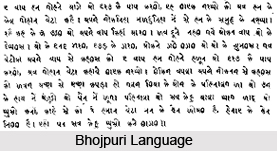 India is a multilingual country, with wide ranging languages finding prevalence in almost every corner of the region. Few are of foreign origin, the rest have got indigenous origin. Amongst multiple vernacular languages, Bhojpuri deserves special mentioning. It is widely spoken mainly in north central and also some of the eastern provinces of Indian subcontinent. States like Bihar, north west of Jharkhand speak Bhojpuri along with other speakers residing in Uttar Pradesh`s Purvanchal region and its suburbs. Other regions where Bhojpuri is famous are Assam, Delhi, Madhya Pradesh, Uttar Pradesh and West Bengal. The alternative names for Bhojpuri are Bhozpuri, Bajpuri, Bihari, Deswali, Khotla, Piscimas.
India is a multilingual country, with wide ranging languages finding prevalence in almost every corner of the region. Few are of foreign origin, the rest have got indigenous origin. Amongst multiple vernacular languages, Bhojpuri deserves special mentioning. It is widely spoken mainly in north central and also some of the eastern provinces of Indian subcontinent. States like Bihar, north west of Jharkhand speak Bhojpuri along with other speakers residing in Uttar Pradesh`s Purvanchal region and its suburbs. Other regions where Bhojpuri is famous are Assam, Delhi, Madhya Pradesh, Uttar Pradesh and West Bengal. The alternative names for Bhojpuri are Bhozpuri, Bajpuri, Bihari, Deswali, Khotla, Piscimas.
Evolution of Bhojpuri as a language has a long story behind it. In the beginning the Government of India passed out a rule affirming to Bhojpuri, the status of a Hindi dialect. The Government also implements the procedure of granting Bhojpuri the prestige and `statutory status` of a `national scheduled language`. The vocabulary of Bhojpuri also is related to various languages like Hindi, Sanskrit, Urdu and few other languages of Indo-Aryan family of North India.
In fact a separate group, known as Bihari languages, has been formed where Bhojpuri is an integral part of it. It shares space with other languages like Maithili and Magadhi etc. Bhojpuri, rather the whole of Bihari language group, is again a constituent of eastern part of the Indo-Aryan language family.
Several dialects have evolved from of Bhojpuri language where just from the eastern region of Uttar Pradesh, number of dialects amounts to three or four. Other important dialects include `Northern Standard Bhojpuri (Gorakhpuri, Sarawaria, Basti), Western Standard Bhojpuri (Purbi, Benarsi), Southern Standard Bhojpuri (Kharwari), Tharu, Madhesi, Domra, Musahari.`
Eminent personalities namely, the first president of India, Rajendra Prasad, former Indian prime minister Chandra Shekhar, renowned actors Ravi Kishen and Manoj Bajpai have got Bhojpuri as mother tongues. According to an article published in Times of India, an estimated 70 million people of Uttar Pradesh and 50 million of western Bihar speak Bhojpuri.
The Bhojpuri too is quite enriched where eminent personalities both from ancient period as well the contemporary era had left their mark in the whole of Indian panorama.
Its music, songs too embellish the field of Indian music and art. As per the report published in the year 1994 by the famous organization, IMA, Bhojpuri speakers constitutes of 23,375,000 number while the number goes to 25,000,000 in the whole world.
Bhojpuri language has been acclaimed in the field of education also. It has developed as first language with its literacy rate increasing from five to ten percent over the years. As a second language, Bhojpuri has developed from fifty to seventy five percent.
Although Bhojpuri language has its origin in Indian subcontinent, it has its reach in overseas also.



















